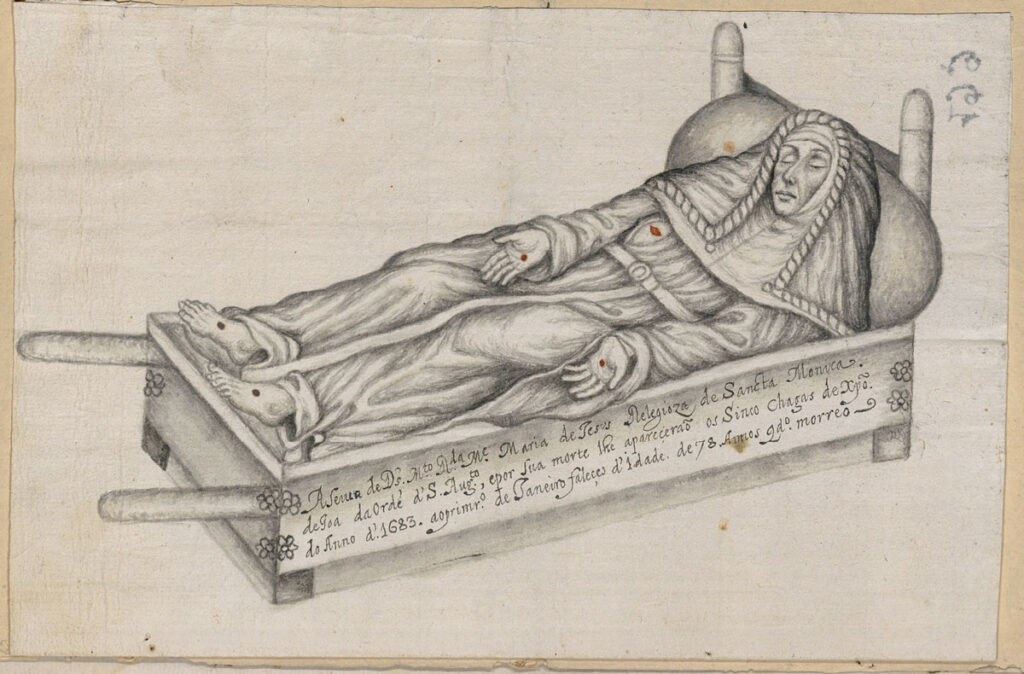The Female Corpse Exhibited
An Investigation of the Authenticity of the Stigmata of Maria de Jesus (1683) and the Representation of the Female Body in Iberian Colonial Asia
By You-Jin Kim
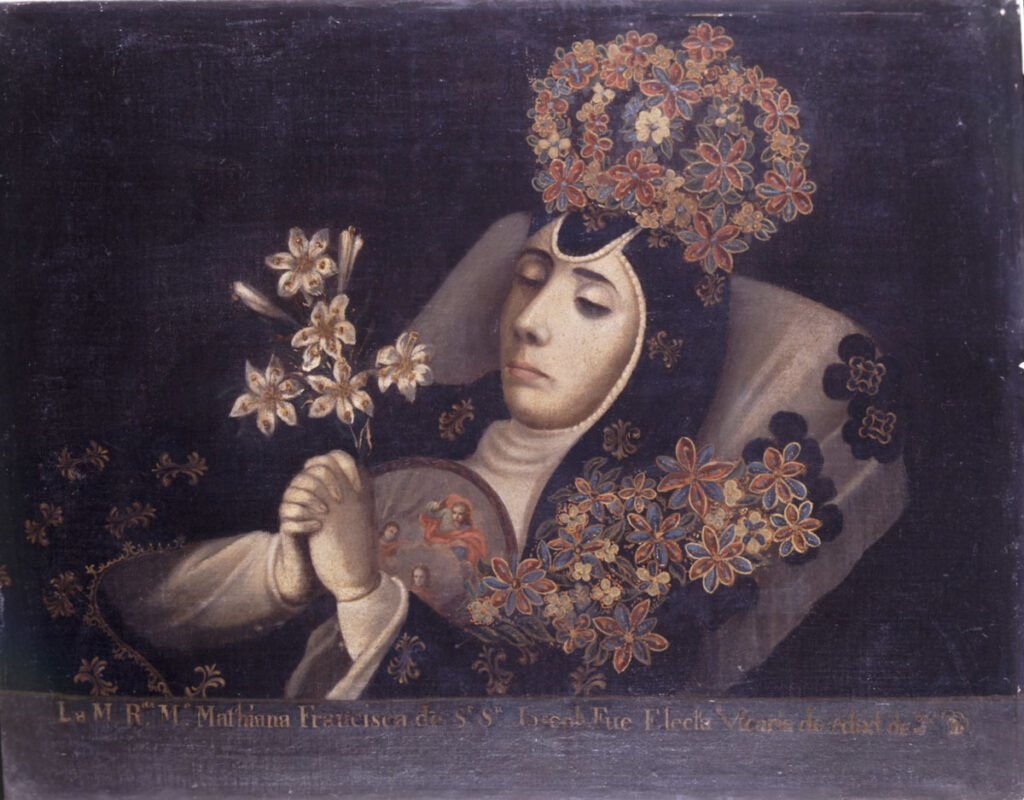
The Spanish Colonial Tradition of Death Portraits: Monjas Coronadas
In Spanish colonial American art, certain revered nuns had the privilege to have their spiritual devotion and legacy remembered and passed down through generations. Crowned-nun portraits, also known as retratos de monjas coronadas, was one of the practices to honor and immortalize these religious women in New Spain (modern-day Mexico) during the seventeenth and eighteenth centuries. These portraits typically commemorated the exemplary lives and spiritual authority of these religious women, either upon their profession of vows or after their death.
Among the different types of crowned-nun portraits, funeral portraits usually depicted the highly respected nuns at the moment of their death, lying on their deathbed and surrounded by lavish floral decorations symbolizing their sanctity. Adornments such as large medals, floral wreaths, and other ornaments were distinctive features of this portrait tradition. The exuberance of materials was not merely for decorative purposes or visual appeal. Instead, the richness of flowers and glittering golden ornaments was considered essential for intensifying the virtue of each individual subject portrayed.1 These material elements often reflected nuns’ daily lives and spirituality.
The illustration to be discussed in this introduction may be examined in light of the crowned-nun portrait traditions. One of the big differences is that it is portraying a deceased nun on her funeral bier yet significantly lacking decorative materials. This introduction explores the historical background surrounding the funeral portrait of the Augustinian nun Maria de Jesus. It also examines the symbolic meanings embedded in the visual representation, particularly in the absence of material elements. Additionally, the stigmata on the deceased body of Maria de Jesus stand out most prominently in the illustration. This introduction discusses how the representation of the stigmata serves to immortalize this religious woman, elevating her sanctity, while simultaneously depriving her of agency over her own body, when her body is objectified to be displayed and scrutinized.
The Spanish Colonial Tradition of Death Portraits: Monjas Coronadas
A renowned nun, known for her piety and devotedness to God, died in 1683 in Goa, when the Portuguese were ruling a large part of the Indian subcontinent. Her name was Maria de Jesus, and she was a professed Augustinian sister at the Convent of Santa Monica of Goa. Upon her death, the governor of Portuguese India, Francisco de Távora, ordered an examination of her body, as she was reported to have died with stigmata. The Prioress, the Confessor, and the sisters at the convent discovered that Maria de Jesus bore the stigmata, often referred to as the Five Holy Wounds, at the moment of her death. These marks appeared as two on each palm, two on each foot, and one on the right side of Maria de Jesus.
The governor convened a committee that consisted of various authorities, ranging from ecclesiastical to civil figures, to conduct a thorough inspection of the corpse, especially to determine whether or not the stigmata were genuine. The examiners scrubbed the stigmata with salt and vinegar to find out the marks would remain intact, which would suggest that they were blessed signs of divine love. When the wounds did not change, the authorities decided to proceed with the funeral protocols for Maria de Jesus.
However, the judicial vicar requested a more thorough investigation, which led to the exhumation of the dead body of Maria de Jesus for a second examination, this time with medical doctors and surgeons involved. The examiners repeated the same salt-and-vinegar experiment, and conducted a more detailed analysis of the stigmata, documenting its size, color, depth, and other characteristics.
In the end, the investigation lasted three days, with four separate examinations conducted. The number of people involved in the process grew with each examination. When the City Council and the archbishopric were informed, they attended an examination at the convent to observe the dead body and the supernatural signs on it. Something different from the first examination was the wound on her side, which looked like a long slit as if she had been speared. It was dark red in color, and despite the chemical experiment, this particular wound became more and more vivid over time. Additionally, the dead body remained soft and flexible even 24 hours after death.
Even the viceroy of the Portuguese Estado da Índia, Francisco de Tavora, was willing to attend the examination in person when he was informed of the case. This led to a larger gathering of political and religious figures for the third examination. A fourth examination was conducted the following day with other friars from different Catholic Orders, who came to observe whether the wound on her side grew larger. One of the friars who had medical knowledge confirmed that the stigmata were divine revelation. He stated,“os ditos sinais lhe parecião sobrenaturais” [“the mentioned signs seemed to him to be supernatural”]. Finally, after the extensive investigation, the dead body of Maria de Jesus was allowed to be buried, while it was reported that blood continued to exude from the openings of her body for three days after her death.
The Archival Location of the Document and the Spiritual Connection Across Iberian Colonial Asia
The miraculous incident that occurred on the dead body of Maria de Jesus was thoroughly recorded in text by the examiners of the Portuguese Estado da Índia. Luis Gonzalez Cotta, who identifies himself as the Secretary of the State of India, presents the case in which he was in charge of incorporating all information possible about Maria de Jesus and a series of inspections followed by her death. His report was addressed to Governor Francisco de Tavora, and it is likely that through the Governor, the report was intended to inform Dom Pedro II in Portugal. The Secretary provides biographical information of Maria de Jesus, including her origin, secular life, and religious life, and finishes the document by giving all the names of those mentioned in this case.
This document is located in the volume titled “Pertenece al aparador fuera de la pared. Cajón número 4. Misiones. Legajo 1,” at the Lilly Library. It was found inserted within one of the bundles that contain Philippine manuscripts from the Spanish colonial period, especially those related to the Augustinian missionary works in the Philippine Islands. Along with the textual report written in Portuguese, there is a folded sheet featuring a colored wash drawing of the defaced nun with the stigmata, lying on a bier.
One question that might come to mind when leafing through this bundle is how the present document initially landed in the archive of a Spanish Augustinian Church. A brief explanation of the Augustinian missions in Asia elucidates the reasons why this document reporting an incident in Portuguese India was housed in a church in Spanish Manila.
Founded in 1533, the archdiocese of Goa prospered along with Portuguese colonialism. It had the central authority among the Portuguese missionaries at overseas posts. It was also the center of colonial administrative power where the viceroy of Portuguese Estado da Índia was seated. Along with the Portuguese colonial administration, there were multiple Catholic orders established in Goa for their missions in Asia. While the Jesuits and the Franciscan Order were predominant, the Order of Saint Augustine was rather a peripheral order in Goa. Instead, it was in the Spanish Philippines where the Augustinians became one of the dominant orders.2
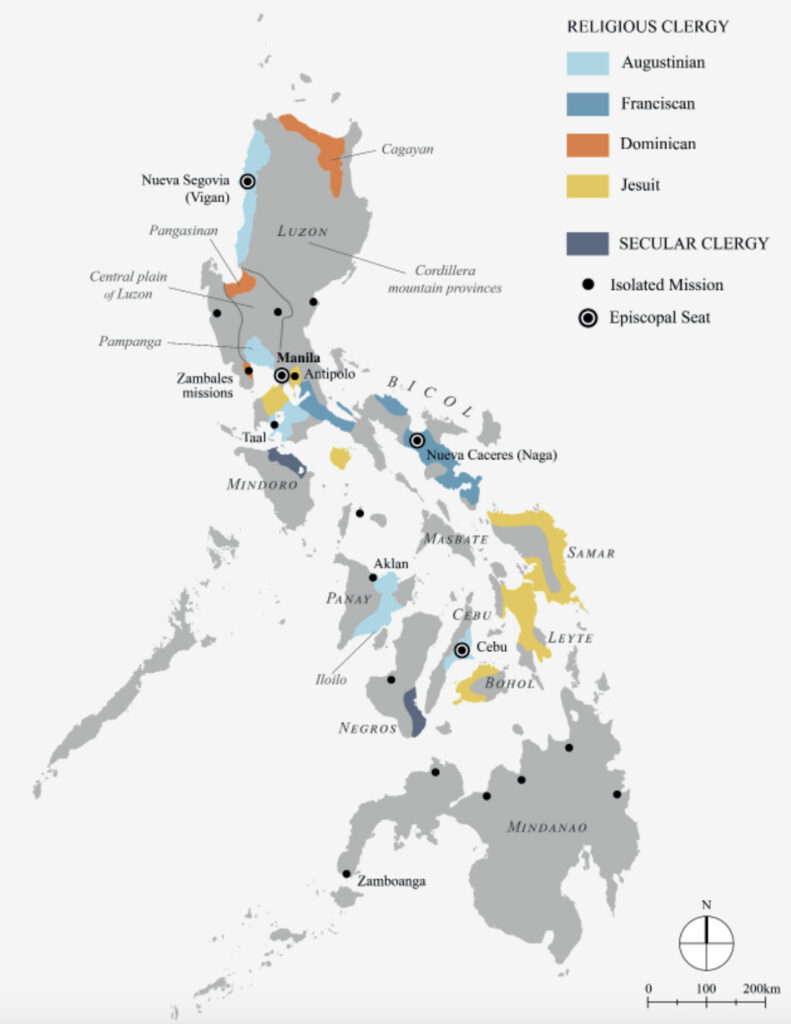
Map of the dominant Catholic Religious Orders in the Philippines. ©Daniel Doeppers
READ THE FULL DOCUMENT
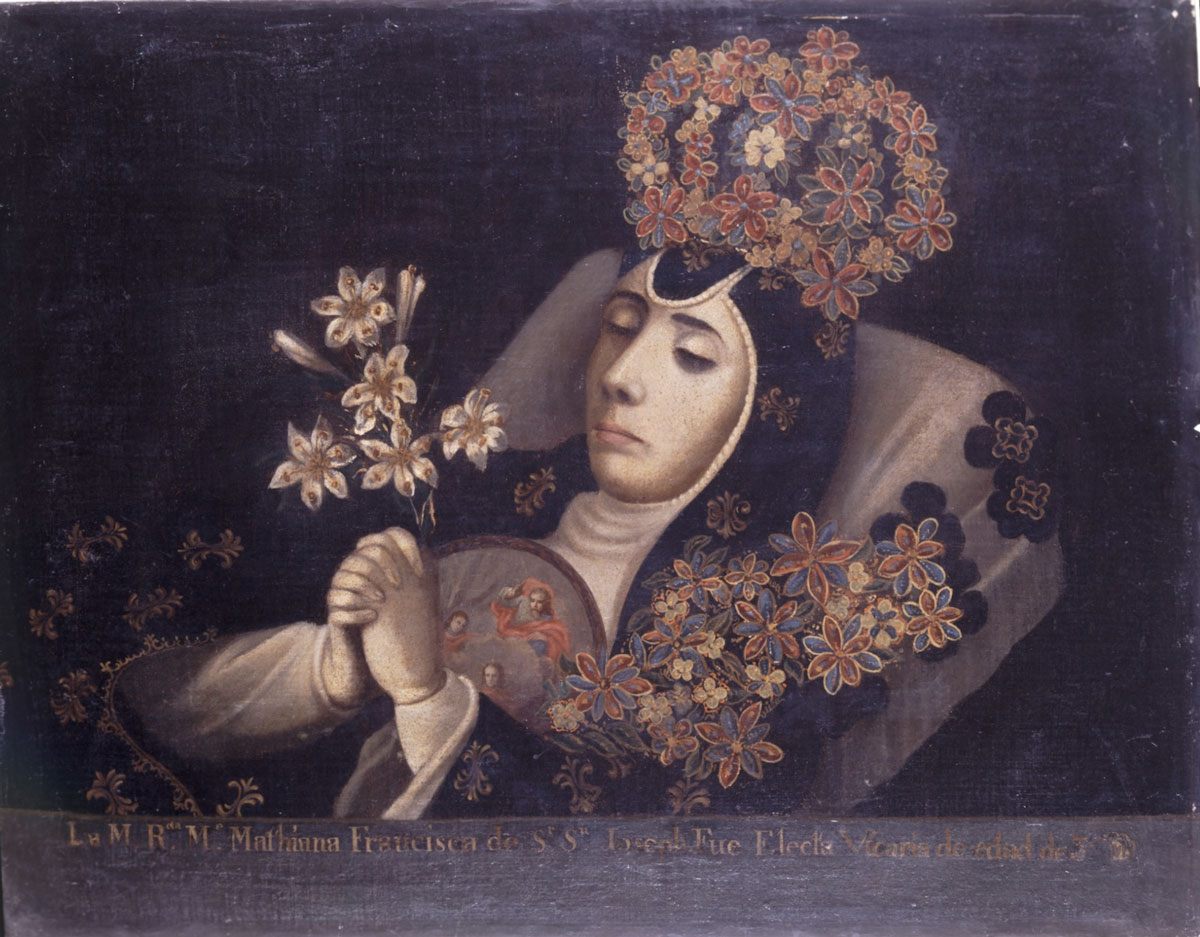
A auto que mandou fazer o excelentíssimo Senhor Francisco de Tavora...
The order his excellency Francisco de Távora of Council of the State of His Majesty ordered on the deceased body of Mother Maria de Jesus of the Convent of Santa Monica of the city of Goa.
8 transcribed and translated pages
View the full document
Santa Maria, Agostinho de. Frei. 1699. História da Fundação do Real Convento de Santa Mônica Da Cidade de Goa, Corte Do Estado Da Índia, e do Império Lusitano do Oriente, fundado pelo ilustríssimo e reverendíssimo senhor Dom. Fr. Aleixo de Menezes. Lisboa: Antonio Pedrozo Galram. Online Access: https://drb-qa.nypl.org/read/3890153.
Secondary ReadingsAlonso Rivera, Adriana Guadalupe. 2021. “Retrato Y Memoria Colectiva: Nuevos Desafíos En Torno al Estudio de La Retratística Monjil Novohispana.” Fronteras de La Historia 26 (1): 62–91. https://doi.org/10.22380/20274688.1440.
Blanco, John D. 2023. Counter Hispanization in the Colonial Philippines: Literature, Law, Religion, and Native Custom. Amsterdam: Amsterdam University Press.
Cairns, Emily Colbert. 2020. “Mother’s Breast Is Best in Early Modern Spain.” Revista de Estudios de Género Y Sexualidades/Revista de Estudios de Género Y Sexualidad 46 (1-2): 19–40. https://doi.org/10.14321/jgendsexustud.46.1-2.0019.
Córdova, James M. 2016. “Images beyond the Veil: Funeral Portraits and Sacred Materialities in New Spain’s Nunneries.” RES: Anthropology and Aesthetics 67/68: 256–72.
Flannery, John M. The Mission of the Portuguese Augustinians to Persia and Beyond (1602-1747). Leiden; Boston: Brill, 2013.
Montero Alarcón, Alma. 2008. Monjas Coronadas: Profesión y Muerte en Hispanoamérica Virreinal. México, D.F.: Museo Nacional del Virreinato : CONACULTA, INAH.
Sperling, Jutta Gisela. 2016. Medieval and Renaissance Lactations: Images, Rhetorics, Practices. London: Routledge.
VIEW OTHER FEATURED TEXTS
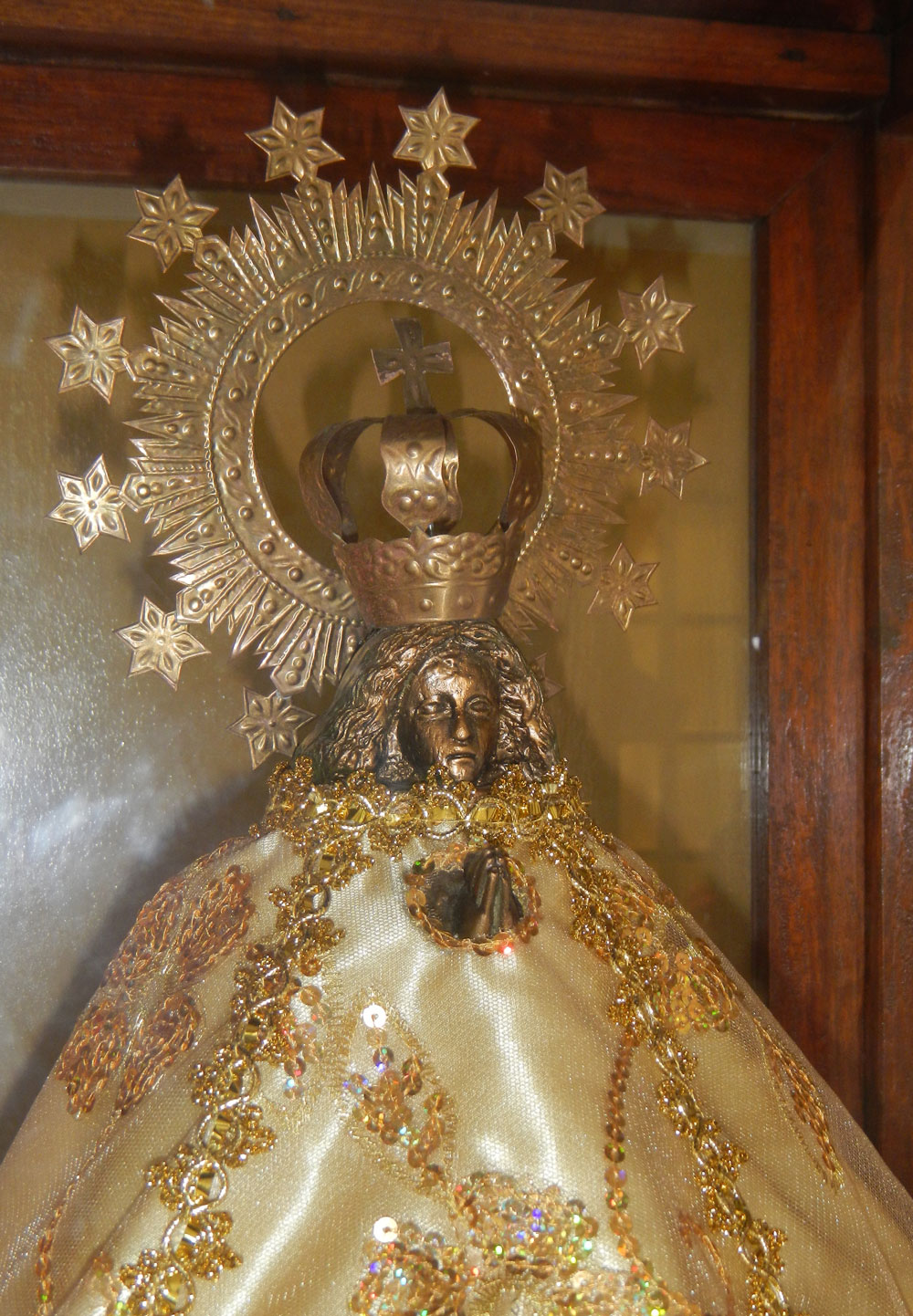
Race, Massacre, and Resurrection in Casaysay
The case at hand is an ecclesiastical investigation that validated a miracle performed by Our Lady of Caysasay, an image of the Immaculate Conception located in Caysasay, near Taal, not far from Manila.
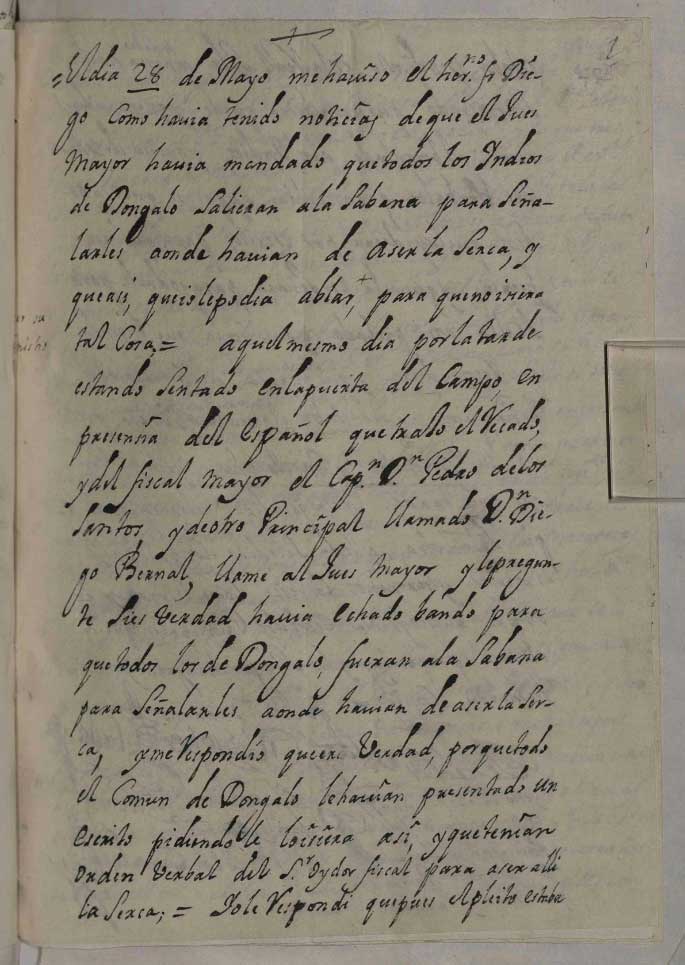
Upheaval and Indigenous Resistance in Dongalo
In May of 1717, a physical skirmish broke out in Dongallo, a town just south of Manila between a group of local principales and Augustinian officials over where the line between their property really was
